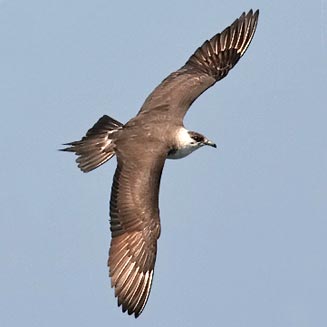|
Stercorarius parasiticus
(Parasitic jaeger, Arctic skua)
Arktiese roofmeeu [Afrikaans]; Kleine jager [Dutch]; Labbe
parasite [French]; Schmarotzerraubmöwe [German]; Moleiro-parasítico
[Portuguese]
Life
> Eukaryotes >
Opisthokonta
> Metazoa (animals) >
Bilateria >
Deuterostomia > Chordata >
Craniata > Vertebrata (vertebrates) > Gnathostomata (jawed
vertebrates) > Teleostomi (teleost fish) > Osteichthyes (bony fish) > Class:
Sarcopterygii (lobe-finned
fish) > Stegocephalia (terrestrial
vertebrates) > Tetrapoda
(four-legged vertebrates) > Reptiliomorpha > Amniota >
Reptilia (reptiles) >
Romeriida > Diapsida > Archosauromorpha > Archosauria >
Dinosauria
(dinosaurs) > Saurischia > Theropoda (bipedal predatory dinosaurs) >
Coelurosauria > Maniraptora > Aves
(birds) > Order: Charadriiformes
> Family: Laridae > Genus: Stercorarius
 |
|
|
Parasitic jaeger, offshore of California, USA. [photo
Jeff Poklen
©] |
|
Distribution and habitat
Breeds in coastal areas of the Arctic Circle, heading south
in the non-breeding season to the shores of the Southern Hemisphere. Within
southern Africa it is common to locally abundant off the southern
and western coast, while more scarce off the Eastern Cape, KwaZulu-Natal and
Mozambique. It mainly occurs in coastal waters, regularly visiting nearby
wetlands and sheltered embayments, although scarce further out to sea.
Movements and migrations
Departs its breeding grounds in the period from
August-September, coinciding with the departure of
Common and
Arctic terns from which it
steals food. It arrives in southern Africa in late September and
October, before mainly departing in April, although a small
proportion of its population stay over winter.
Food
It mainly eats fish, aquatic invertebrates and fishery
waste, doing most of its foraging by stealing food from other birds, especially
small gulls and terns. Up to a
dozen or so jaegers may harass a single bird, largely ignoring readily available
fish, although it occasionally seizes prey from the water surface.
Threats
Not threatened.
References
-
Hockey PAR, Dean WRJ and Ryan PG 2005. Roberts
- Birds of southern Africa, VIIth ed. The Trustees of the John Voelcker
Bird Book Fund, Cape Town.
|
